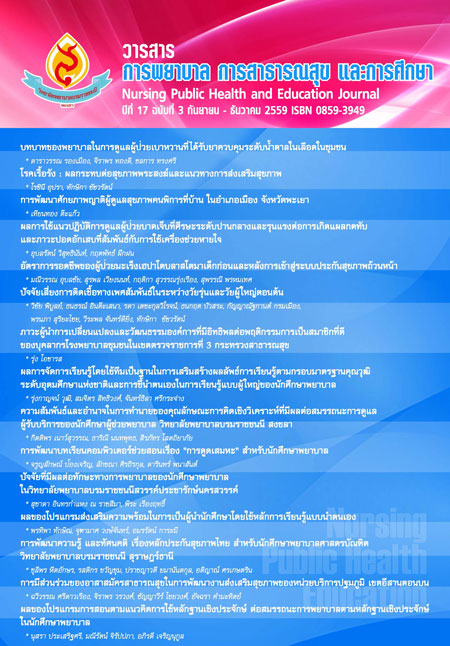การมีส่วนร่วมของอาสาสมัครสาธารณสุข ในการพัฒนางานส่งเสริมสุขภาพของหน่วยบริการปฐมภูมิ เขตอีสานตอนบน
คำสำคัญ:
การมีส่วนร่วมของอาสาสมัครสาธารณสุข, งานส่งเสริมสุขภาพ หน่วยบริการปฐมภูมิ, The collaboration of village health volunteers, health promotion, Primary health care unitsบทคัดย่อ
การวิจัยครั้งนี้เป็นวิจัยเชิงพรรณนา มีวัตถุประสงค์การวิจัย เพื่อศึกษาลักษณะการมีส่วนร่วมของอาสาสมัครสาธารณสุข (อสม) และศึกษาความสัมพันธ์ระหว่างปัจจัยการสนับสนุนกับการมีส่วนร่วมของอสม. ในกิจกรรมงานส่งเสริมสุขภาพ ของหน่วยบริการปฐมภูมิ อีสานตอนบน เขตสุขภาพที่ 8 กลุ่มตัวอย่างในการวิจัยเป็น อสม.ที่ปฏิบัติงานส่งเสริมสุขภาพใน รพ.สต. ทั้ง 10 แห่ง จาก 6 จังหวัดในเขตอีสานตอนบนที่ถูกคัดเลือกเข้าประกวดสถานบริการและบุคคลทรงคุณค่าจำนวนทั้งสิ้น 142 คน เป็นการคัดเลือกกลุ่มตัวอย่างแบบสุ่มอย่างง่าย เครื่องมือที่ใช้ในการวิจัยคือ แบบสอบถามประกอบด้วย 3 ส่วนคือ ส่วนที่ 1 ข้อมูลลักษณะทางประชากรและสังคม ส่วนที่ 2 ข้อมูลการสนับสนุนจากเจ้าหน้าที่ การสนับสนุนของประชาชน และการสนับสนุนด้านการปฏิบัติงาน ส่วนที่ 3 การมีส่วนร่วมของอาสาสมัครสาธารณสุขและภาคีเครือข่ายในการพัฒนางานส่งเสริมสุขภาพ ตรวจสอบคุณภาพของเครื่องมือ ได้ค่าความเที่ยงเท่ากับ 0.89 การวิเคราะห์ข้อมูล ใช้สถิติเชิงพรรณนา ร้อยละ ค่าเฉลี่ย ส่วนเบี่ยงเบนมาตรฐาน และวิเคราะห์หาความสัมพันธ์ (Correlation Pearson Product Moment) ผลการวิจัยพบว่า กลุ่มตัวอย่างส่วนใหญ่เพศหญิง 96 คน (67.6%) ส่วนใหญ่อายุมากกว่า 50 ปีขึ้นไป (26%) ส่วนใหญ่มีประสบการณ์ทำงาน อสม.อยู่ในช่วงไม่เกิน5 ปี (31.41%) ส่วนใหญ่ประกอบอาชีพทำนา (77.47%) สำหรับความคิดเห็นของ อสม. ต่อการสนับสนุนจากเจ้าหน้าที่ การสนับสนุนของประชาชน และการสนับสนุนด้านการปฏิบัติงาน พบค่าเฉลี่ยสูงสุดในเรื่อง การจัดกิจกรรมส่งเสริมสุขภาพ อสม. และภาคีเครือข่าย ร่วมแรงร่วมใจในการทำงานอย่างเข้มแข็ง (Mean 4.43; SD 0.66) และพบค่าเฉลี่ยต่ำสุดในเรื่อง งานที่ต้องรับผิดชอบในการส่งเสริมสุขภาพเป็นภาระกับ อสม. (Mean 3.23; SD 1.32) ในด้านการมีส่วนร่วมของอสม.และภาคีเครือข่ายในการพัฒนางานส่งเสริมสุขภาพพบค่าเฉลี่ยสูงสุด ในเรื่องการมีส่วนร่วมในการแนะนำประชาชนในการกำจัดแหล่งเพาะพันธ์ยุงลาย (Mean 4.63; SD 0.77) และพบค่าเฉลี่ยต่ำสุดในเรื่องการมีส่วนร่วมในการเสนอข้อคิดเห็นเกี่ยวกับปัญหา อุปสรรคการดำเนินงาน การปรับปรุงแก้ไขเกี่ยวกับระบบการทำงานร่วมกับเจ้าหน้าที่สาธารณสุข (Mean 3.90; SD 1.03) ความสัมพันธ์ของปัจจัยการสนับสนุน กับการมีส่วนร่วมของ อสม.และภาคีเครือข่ายในการพัฒนาส่งเสริมสุขภาพพบว่า มีความสัมพันธ์อย่างมีนัยสำคัญทางสถิติ (r=0.509, p < 0.01) ข้อเสนอแนะจากการวิจัยและการนำไปใช้คือ เจ้าหน้าที่สาธารณสุขควรมีการเปิดโอกาสให้ อสม.เข้ามามีบทบาทในการวางแผนในเรื่องการสร้างเสริมสุขภาพกับองค์กรปกครองส่วนท้องถิ่นและหน่วยงานสาธารณสุขทุกระดับและสนับสนุน ในเรื่องขวัญกำลังใจให้กับอาสาสมัครสาธารณสุขในการสร้างสุขภาพแก่ประชาชน ด้านการจัดการควรมีการสนับสนุนการเพิ่มทักษะให้กับอสม.ในด้านการสร้างสุขภาพ การส่งเสริมให้ชุมชนดูแลสุขภาพให้กับบุคคลในชุมชน การวิเคราะห์ปัญหา การวางแผน และการเสนอโครงการของบประมาณและสนับสนุนสิ่งของต่างๆ ด้านการวิจัย ควรมีการศึกษาวิจัยเชิงคุณภาพ แนวทางการแลกเปลี่ยนเรียนรู้การทำงานของ อสม ในการสร้างสุขภาพประชาชน
The collaboration of village health volunteers: Working on health promotion in primary health care units, North part of Isan region
This descriptive study aimed to study the participation of village heath volunteers on health promotion, and to determine the relationship between the supportive factors and the participation of health volunteers, particularly for health care promoting activities in primary health care units, North part of Isan region.
142 Health volunteers and health care partners, working in 10 health promotion hospitals from 6 provinces in the region 8 were recruited for the participants, by using simple random sampling technique. Measurements comprised 3 questionnaires which were 1) demographic questionnaire 2) Supportive factors from health professionals, residents, and working process 3) the participation of health volunteers and health care alliances, regarding health promotion improvement. Reliability was also tested (alpha conbrach = 0.89). Descriptive statistics including, frequency, percentage, mean and standard deviation were used for demographic data and the participation questionnaires. Correlation Pearson Product Moment was used to determine the relation of these factors.
The finding showed that the majority of participants were female (67.6%), with greater than 50 years of age (26%). Most of them have been working as village health volunteers less than 5 years (31.41%). Agriculture occupation was most reported (77.47%). In terms of supportive factors, the participants reported the highest level of supportive on the great cooperation of health promoting activities (Mean = 4.43; SD = 0.66). The lowest average mean score of supportive factors found in the topic of working as health volunteers was overload job (Mean =3.23; SD =1.32). Regarding the participation of village health volunteers and health care partners on health promotion, results found that participating in health education of Aedes aegypti larva control project was the highest level (Mean =4.63; SD= 0.77) and the lowest level was the participation in suggestion regarding the difficulties and obstacles during working process, and improvement plan when dealing with health care professionals (Mean= 3.90; SD= 1.03). In addition, the supportive factor was positively correlated with the participation on health promotion statistically significant (r=0.509, p < 0.01). This study gave potential suggestions that the health care professionals should give opportunity for village health volunteers and staff from local administrative organization to participate in health promotion plan. Furthermore, essential skills such as health promotion techniques, problem analysis, and funding management should be trained for health volunteers. Further qualitative research regarding the strategy to encourage health volunteers’ participation on health care promotion is required to explore in-depth.



